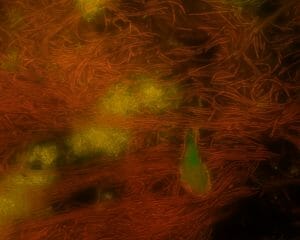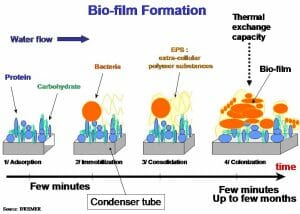Biofilm Definition
A biofilm is a thick layer of prokaryotic organisms that have aggregated to form a colony. The colony attaches to a surface with a slime layer which aids in protecting the microorganisms. There are a number of reasons why biofilms are formed, all of which promote growth and survival or the microorganisms. Biofilms are found in almost all environments, and can have negative effects.
Biofilm Structure
A microbial biofilm is made up of many prokaryotic organisms that combine to form a colony. The colony is adhered to a surface and coated with a polysaccharide layer (or slime layer). The slime consists of many porous layers with channels which allow the cells in the centre of the colony to receive nutrients and remove waste products.

This figure depicts a biofilm composed of both gram positive and gram negative bacteria.
A biofilm is formed and maintained via cell-to-cell communication. A biofilm first forms when one or a few cells attach to a surface. These first cells produce proteins that act as signals to nearby cells. The signals are detected by neighboring cells and essentially recruit new cells into the colony. As the nearby cells detect the chemical cues they aggregate and begin to form the biofilm. These cells then send out additional signals, recruiting more cells to the colony and growing the biofilm. The proteins also signal the development of polysaccharides that will form the slime layer. This slime layer forms over and around the growing colony.
Biofilm Function
The microorganisms in a biofilm aggregate to form a colony for metabolic cooperation. This cooperative method of growth increases the cells’ survival through improved defense, increased availability of nutrients, and better opportunities for cellular communication and transfer of genetic material.
Cellular defense is important to combat physical threats such as displacement by a flowing fluid or removal by the immune system. The polysaccharide coating on the biofilm acts as an adhesive to attach the colony to a surface. This prevents removal of the cells by physical force. It also prevents penetration of the biofilm by the immune system or antibiotics. Biofilms can be difficult to remove and can cause risks to human health. For example, with cystic fibrosis a biofilm can form in the lungs leading to adverse symptoms. Dental plaque is another example of a bacterial biofilm; this can lead to cavities and gum disease. A number of other bacterial conditions may also be caused by biofilms including cholera, tuberculosis, and Legionnaire’s disease.
The biofilm provides a favorable environment for the microorganisms. The cells adhere to a surface with increased nutrient source, retaining the cells in an optimal niche. The cells are in close proximity which allows for ease of cellular communication through signal molecules. The proximity also provides increased opportunity for horizontal gene transfer, or exchange of genetic material among cells.
Quiz
1. Which of the following is not a reason for biofilm formation?
A. reproduction
B. defense
C. communication
D. growth
2. What is the slime layer made of?
A. protein
B. fat
C. sugar
D. none of the above
3. Where are biofilms found?
A. in the ocean
B. in animals
C. on metal surfaces
D. all of the above
References
- Madigan, M. T., & Martinko, J. M. (2006).Brock biology of microorganisms, 11th. ed. Ch. 19. Upper Saddle River, NJ: Pearson Prentice Hall. ISBN: 0-13-144329-1.
Biofilm

No comments:
Post a Comment